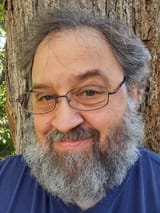Radio Ramblings: 26 July 2024 CE
It's been three months since I last rambled about radio, which might lead some of you to think I've already given up on the hobby.
Nothing—almost literally nothing—could be further from the truth. I just haven't been writing about it. Not sure why not, since several of you made it clear you were paying attention. At any rate, I'm going to try to get this department of my blog out of hibernation with a bit of catch-up, here. This is not going to be comprehensive of everything I've been up to, and it won't be chronological, necessarily, but it covers the high points!
Solving for noise
When last we left our intrepid nerd, he found that he was more or less forced to operate portably. The forcing-function here was simple: radio noise. Any time I set up at home, I found the 15m, 17m, and 20m bands unusably blanketed with screaming differential-mode noise.
Now, with common-mode noise, there are a lot of ways to mitigate it, the cheapest of which is to simply throw ferrites onto cables. If you've got a power plug, monitor cable, or USB cable that has one or two cylindrical protrusions attached to the cable? That's what I'm talking about.
Differential-mode noise, though, you have to filter at, or eliminate, the source to really get rid of it. Ferrites won't do. You need a special power strip, or to actually monkey with the AC power hardware on the device itself. I've already replaced one power strip, the one on my desk with all my work equipment, but the rest of the office remains on older stuff, and the noise persists.
After months of planning to do it, Pixel (my spouse for those few of you who are strangers) and I managed to finally find time to do the circuit-breaker exercise. The idea is simple: I set up my radio the way I might if I were playing backyard portable; she flips breakers until the noise floor drops. We coordinated via good old unlicensed walkie-talkies.
We found the culprit room within three breakers, making what could have been an all-evening exercise a much shorter event. Unsurprisingly, the source was was somewhere in the office. After that, the trick became isolating it further.
Long story short: the noise source was a single external spinning-platter hard drive, of ancient vintage, on Pixel's desk. She had largely forgotten it was even there, hadn't actually used since dinosaurs were soft and rocks roamed the Earth. If it had still been a necessary device, we would have had to try various things to isolate its noise—the new filtering power strip, or replacing its power brick, or something.
But she didn't actually need it. So, we just unplugged it. Voila, no more noise!
I am now able to operate from my own backyard, and in theory, from the house itself, although I'm still not physically set up for that. It's still not as quiet as being at a park, but it's plenty quiet enough to actually make contacts. This, in turn, has dramatically increased how much time I have to just tinker with things!
More parks!
This change, dramatic as it is, has not dimmed my enthusiasm for Parks on the Air. In the last several months, for example, I have made it to:
US 7839 Santa Fe Prairie State Nature Reserve, Illinois
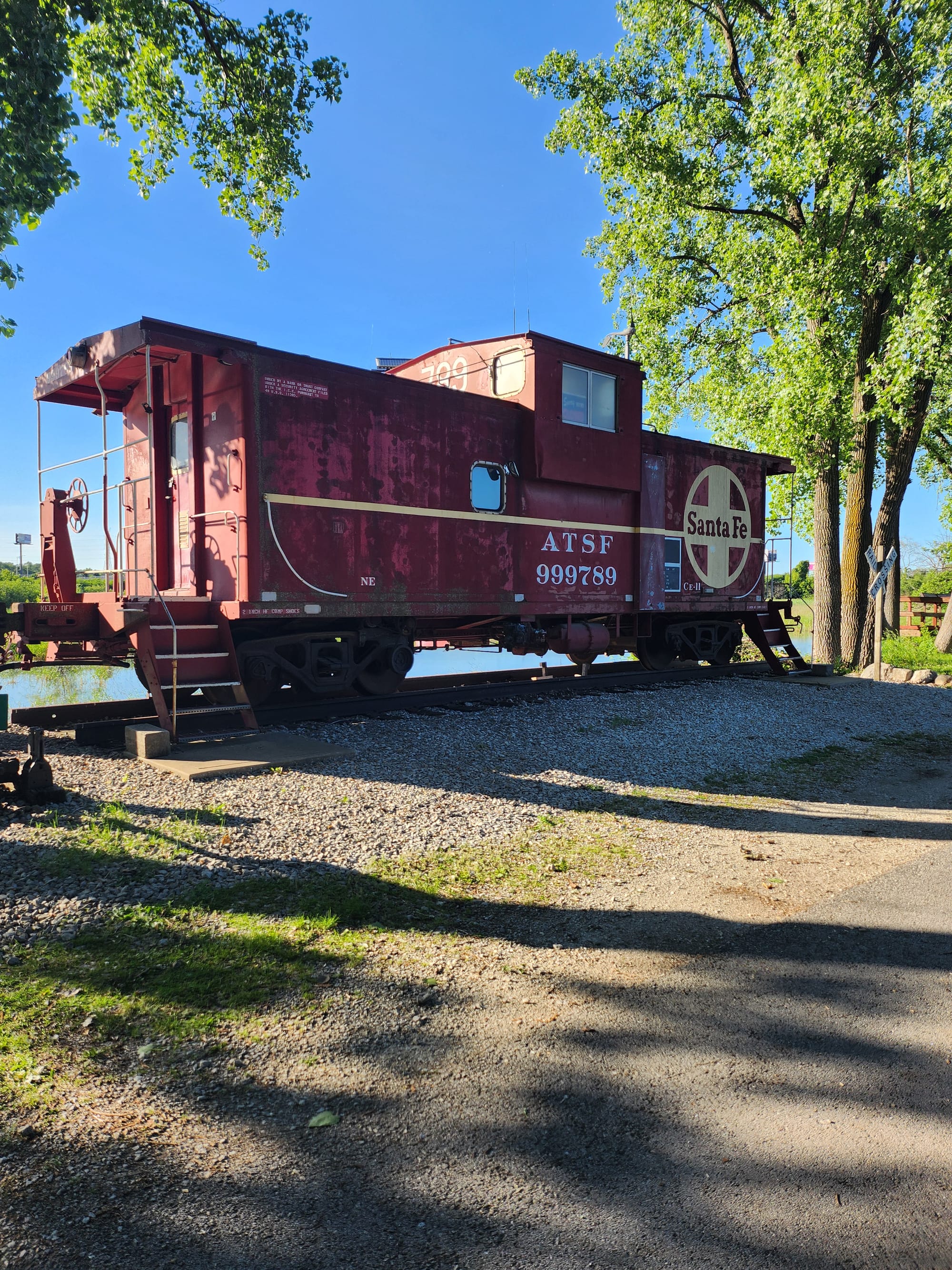
This is a small state park in Chicagoland (Santa Fe Prairie) whose rangers appear to all be hams. The Santa Fe caboose that gives the place its name has hamstick antennas on the roof and they offered me a feedline to it. I wound up setting up my own antenna, but I was deeply amused at how ham-friendly this park is.
US 1442 Brunet Island State Park, Wisconsin
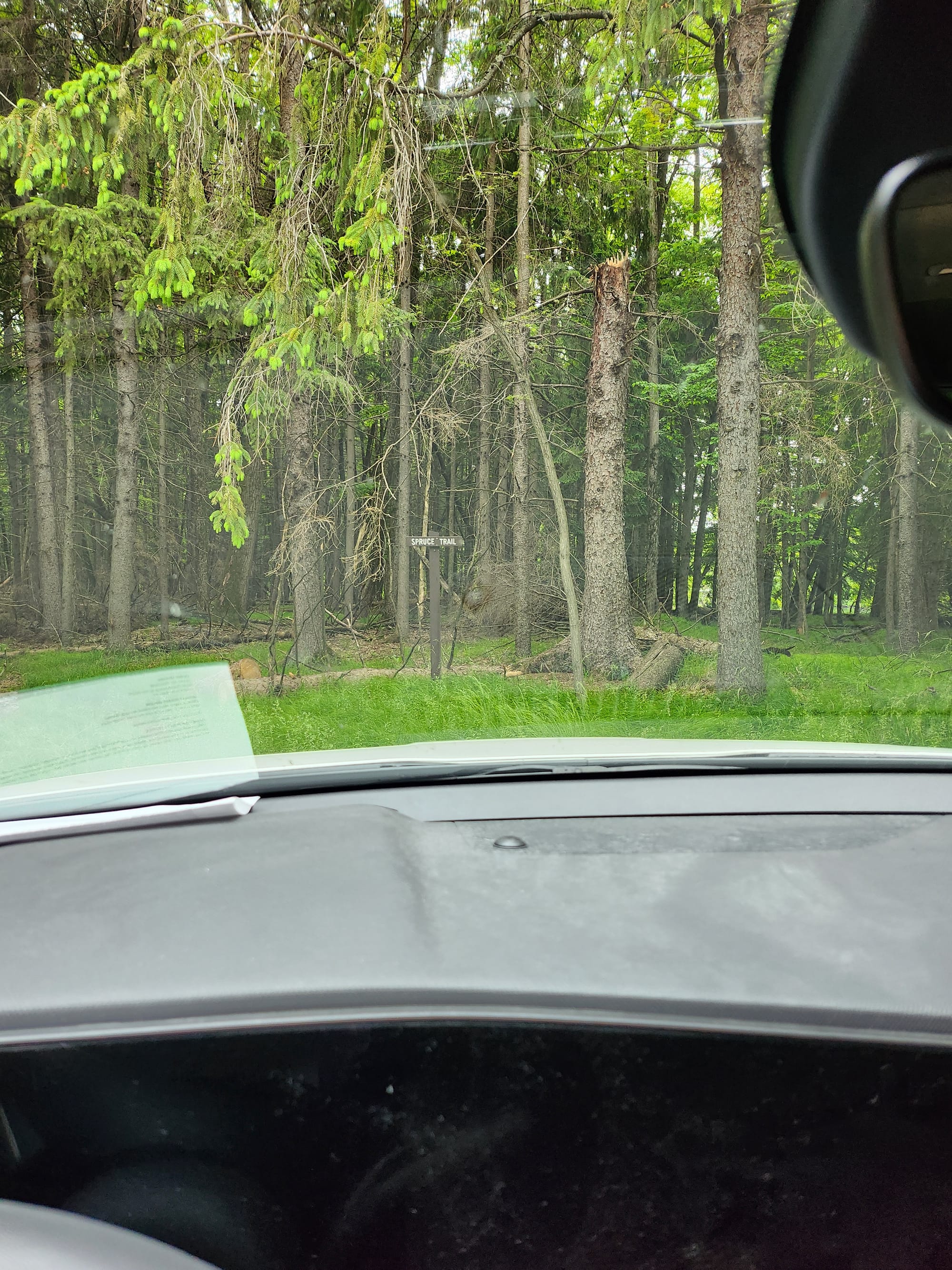
This was on my way home from the Chicagoland trip. This park got on my radar thanks to Michael Martens, KB9VBR, whose YouTube channel I follow closely. This was an in-car activation, as it was already evening and I wanted to set up and tear down quickly so I could get a good chunk of radio time in, and still get home at a decent hour. It's just a little ways north of Eau Claire, so it's not at all out of the question I'll be going back at some point just to go there.
US 2510 Minneopa State Park, Minnesota
This is down by Mankato, and the park includes a bison preserve! Alas, I did not see any fluffy cows. This was one of two joint activations I did in short order, this one with my friend Mike WX0MIK. We had some issues with mutual interference, prompting me to add a bandpass filter to my kit (with more on the list for other bands), but we managed to make it all work in the end.
US 2493 Interstate State Park, Minnesota
As the name alludes, there are actually two Interstate State Parks, one in Minnesota, and one directly across the St. Croix in Wisconsin. I had originally thought I might try to activate both on the same day, but once I was set up and operating, I decided I was comfy. I found a nice, fairly shady spot in the picnic area, which was never empty, but also never crowded. Got to talk to some kids who were fascinated by what I was doing, which I genuinely enjoy.
US 2482 Fort Snelling State Park, Minnesota
This, of course, is the one I had been hitting all the time. I hit it several times in the last three months, including a joint op with Brian, KE0RIY, on a Friday we both had off. This was another day of learning to deal with mutual interference, even with a bandpass filter, but again, it all worked out.
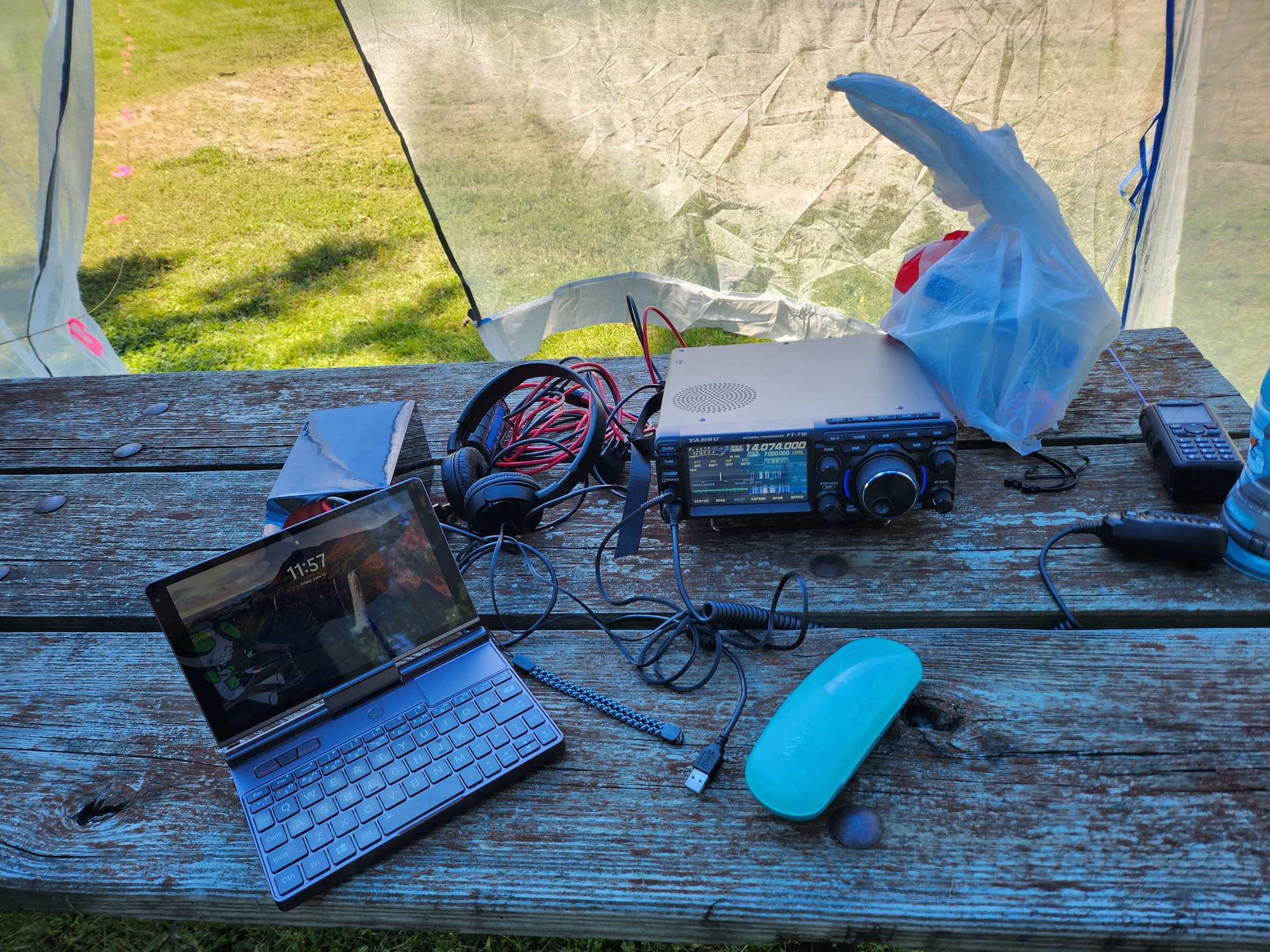
Unfortunately, Snelling has been entirely closed for the last month, and may be closed for some time to come. The park experienced significant flooding from the Minnesota River, and the last time that happened, cleanup took six months!
This, plus weather issues and other obligations, has kept me from doing so much as a single activation for all of July, but made me very glad I can at least operate out of my backyard, now!
ARRL Annual Field Day
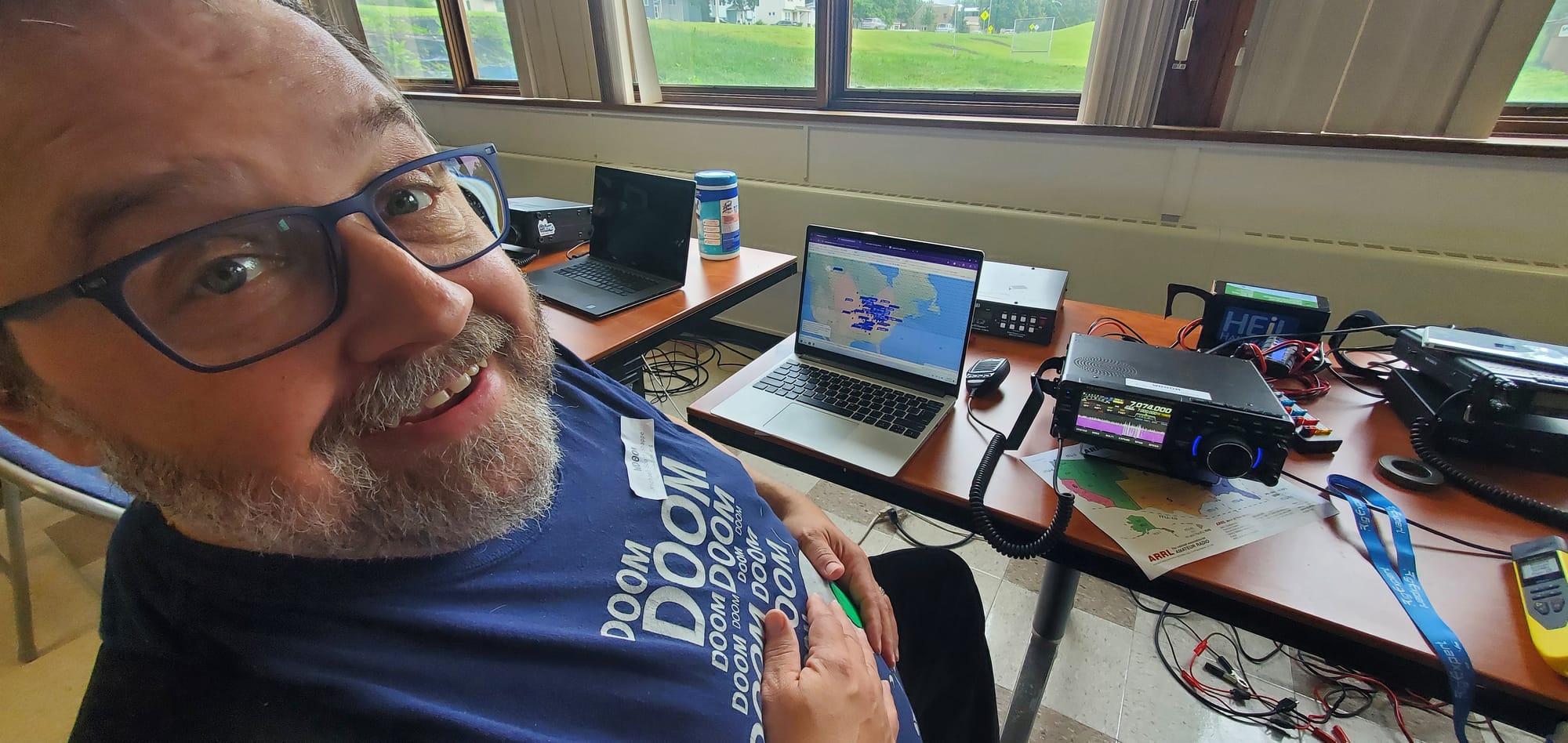
The end of June brought the annual Field Day, which I participated in along with the Richfield Radio Club. This was my second field day—one of my earliest radio experiences was Winter Field Day back in January—only this time, I got to actually operate. I wound up doing a tandem operation with the club president, Matt KB0TNG. He'd been wanting to play with an FT-710, which is my main radio. We also put up my Wolf River Coil so we could have some flexibility with bands. I wound up lending someone else my 20m bandpass filter, and we wound up working 40m.
Ordinarily, 40 is not super-useful during the day, unless you're looking for much more regional/local contacts. We gambled on the idea that, during a contest-like environment such as Field Day, there would be enough other stations on, regionally, to make it worthwhile, especially when we were focusing on FT8, rather than voice.
We were right! I don't remember how many we finally scored, but it was basically "plenty". It was fun watching the circle of our contacts widen as the day progressed and conditions changed.
Beginning to learn CW
Morse Code has always been my bugbear. It kept me from even considering the radio hobby, years ago, because I was simply not convinced I could learn it. Even after it was no longer required, it remained a mental block against getting licensed.
Well, I've now come far enough into the hobby that I really want to know it. Some of the lower power radios I've started playing with (I think I'll save that for another article, with pictures!) are really meant for use with CW and digital modes. One is even exclusive to them by design—the QMX lacks the necessary firmware for single-sideband modulation (although the hardware will support it, so eventually they promise the firmware will). So, I have joined the Long Island CW Club, and begun taking their online classes. I've gotten myself an old-style straight key to practice on.
Wrapping up
I have a lot more I can ramble about, but I like to keep these articles from getting too long. Sometime soon, I'll be posting thoughts about the...multiple radios I seem to have accumulated; and other experiments I've been playing with!

